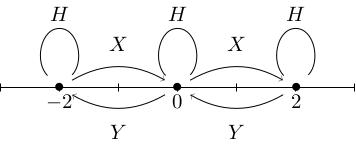The point is that we don't know what means if because is a real Lie algebra so we need to complexify it, but we do know what means because is a complex Lie algebra and we don't to complexify it.
X and Y
From su(2) to sl(2,C)
Last time we saw that, given a complex representation there is a weight space decomposition such that with respect to this splitting, is the diagonal matrix where are the weights of the representation.
At the level of Lie algebras, we have so
In other words, we know where one of the matrices in goes under . But there are other matrices in : the general element is ; where do these go?
Pick the basis for (corresponding to the , and directions). These (or closely related versions of them) are often called the Pauli matrices.
I've told you what is, and since is linear (determined by its values on a basis) it's enough to say what and are to determine completely. It turns out to be much easier to use:
The problem is that these correspond to complex values of and , so they don't live in . Instead, they live in . In fact, and live in and is equal to where . So it turns out that : anything inside can be written as a complex linear combination of and anything inside can be written as a complex linear combination of , , and .
If is a representation of Lie algebras where is a complex vector space, then we get for free a representation , just by setting .
How do X and Y act?
Let
be a complex representation and write
for the sum of all subspaces with weight
. In other words, we're grouping the irreducible subrepresentations for the diagonal
into subspaces with a common weight. We'll call
the
For , , and are each 1-dimensional (spanned by , and respectively). We draw this as a weight diagram:

The following lemma tells us how , and act in the representation:
-
acts on as , i.e. if then .
-
sends to , i.e. if then .
-
sends to .
In terms of the weight diagram earlier, we can draw arrows which show how , and act: sends the weight spaces back to themselves, shifts to the right, and shifts to the left. Note that in the example of , sends to , but , so annihilates elements of .

This is what I meant when I said that the off-diagonal elements of mix up the weight spaces: they do so in a very precise way. Also, you can see why and are more convenient than and : these would mix up weight spaces in a messy way that combines the and arrows.
-
We have already proved part (1) of the lemma: we know that implies , and , so .
-
We'll do (2) and leave the very-similar (3) as an exercise. I'll drop the superscript from now on. Suppose that . We want to show that . Note that if and only if and if and only if .
We know that , but we can't just commute past . However, we know that , and since is a Lie algebra homomorphism we have .
Therefore as required.
Pre-class exercise
Suppose that is a representation with weight decomposition . Show that sends to .